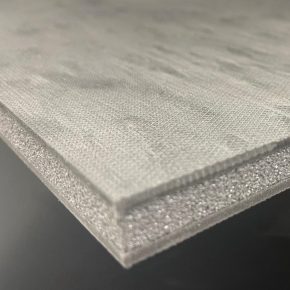
GUEST ARTICLE: Structural Concrete in a Zero Carbon Future
As the UK works towards achieving net-zero carbon, we need to ensure concrete is doing its bit, says Paul Astle, Principal Structural Engineer at Ramboll, in this guest article.
“Whilst concrete is a low carbon material by weight (with only about 7% of the embodied carbon of steel[1]), we use it in such vast quantities that our concrete carbon footprint is huge.
In fact, a cubic metre of typical structural concrete has an embodied carbon of between 250kg-500kg CO2e, a similar quantity as that of a barrel of crude oil.
However, as the material will be largely responsible for meeting the demand for new buildings and infrastructure in years to come, how will we reconcile the need for new development with the need to reduce our emissions to net zero in just 30 years?
Reducing the amount of concrete we use is an obvious first step, especially since concrete is rarely utilised to its full potential. In fact, a University of Cambridge report highlighted that structural elements are typically only designed to utilise 60-80% of their capacity[2] – this is after all safety factors have been applied.
There are also interesting opportunities that may allow a renaissance in stunning concrete structures. By sculpting concrete, we can cut out material and place as much of it is as possible in a compressive state.
Whilst these ideas are not new, the design and construction challenges have limited their implementation. However, thanks to technological advances, we are now able to tackle these challenges with computational power, advanced digital manufacturing, and a drive for low-carbon structures.
Additionally, researchers at ETH Zurich have been working on how to apply computational design to create some compression-only concrete elements using innovative forming techniques to remove unnecessary concrete[3], resulting in visually impressive, as well as materially efficient structures.
It is also important we minimise the amount of cement in concrete. In many cases, more cement is used than is needed to meet the requirements.
In a study by Ramboll of over 90 concrete mixes used in UK projects[4], it was found that the total quantity of cement (binder) in the concrete varied from 300kg/m3 to 525kg/m3, even for the same specified strength.
There can be technical reasons for an increased cement content, but the range measured is far in excess of the minimum code requirements.
Portland cement is responsible for the greatest proportion of concrete’s carbon emissions. In concrete using pure Portland cement, it represents only 10-20% of the concrete by weight, yet accounts for up to 90% of the embodied carbon[5].
Increased replacement of Portland cement with supplementary cementitious materials (SCM) allows us to reduce carbon intensity of the cement. However, the two most common SCMs,
Ground Granulated Blast Slag and Fly Ash, are co-products of steel blast furnaces and coal fired powered stations respectively. The life of these SCMs is therefore limited by our responsibility to also consider the carbon intensity of those industries.
However, towards the mid-century these current SCMs will be in short supply. It is likely that we will start to blend a greater number of SCMs with a shrinking volume of pure Portland cement.
These will likely use calcined clays and ground limestone, in addition to other materials. Furthermore, it has been proposed that by 2050 we will need to be recycling 20% of cement paste from demolition waste as new feedstock to cement kilns[6].
Through a better understanding of behaviour, optimised design, carbon-focused specifications and an increased use of SCMs, steps can now be taken to reduce unnecessary concrete, cement and carbon.
Longer term we need to develop and utilise new concrete technology with new mixes, designs and forms of construction. I believe the carbon constraint will catalyse rather than hinder innovation, and we may discover that the solutions supersede their carbon intense predecessors.”
Sources
[1] Inventory of Carbon and Energy (ICE) V3 Nov. 2019.
[2] Minimising Energy in Construction (MEICON) Survey Report. University of Cambridge. 2018.
[3] Block Research Group. ETH Zurich. 2020
[4] Unpublished analysis of 92 concrete mix certificates from projects in the UK. Ramboll. 2020.
[5] Authors calculations based on ICE data.
[6] Absolute Zero. UK FIRES. 2019.
Latest news

29th April 2024
Hush: New Hushlay options offer acoustic upgrade potential
Leading UK acoustic systems manufacturer Hush Acoustics has introduced two additional variants of its Hushlay Soundmatting product.
Posted in Acoustics, Noise & Vibration Control, Articles, Building Industry News, Building Products & Structures, Building Services, Facility Management & Building Services, Floors, Innovations & New Products, Insulation, Restoration & Refurbishment, Retrofit & Renovation
29th April 2024
Digital Construction Week 2024 speaker programme announced
The programme at Digital Construction Week is carefully designed to help you keep up with the fast pace of innovation in the built environment.
Posted in Articles, Building Industry Events, Building Industry News, Building Products & Structures, Building Services, Exhibitions and Conferences, Innovations & New Products, news, Posts, Restoration & Refurbishment, Retrofit & Renovation, Seminars, Sustainability & Energy Efficiency
29th April 2024
Steel Window Association - for the specialists in domestic and commercial refurbishment of steel windows
The UK-wide Steel Window Association members are the established, proven experts in the renovation and sympathetic refurbishment of steel windows and doors in both domestic and commercial premises.
Posted in Architectural Ironmongery, Articles, Building Associations & Institutes, Building Industry News, Building Products & Structures, Building Systems, Doors, Glass, Glazing, Restoration & Refurbishment, Retrofit & Renovation, Steel and Structural Frames, Windows
29th April 2024
The Rooflight Association: Rooflights & Fire Regulations - what you need to know
The Rooflight Association has published a series of ‘Quickguides’, covering the fire rating requirements for use of rooflights in buildings for each of the four devolved UK nations.
Posted in Articles, Building Associations & Institutes, Building Industry News, Building Products & Structures, Building Regulations & Accreditations, Building Services, Ceilings, Health & Safety, Innovations & New Products, Lighting, Publications, Restoration & Refurbishment, Retrofit & Renovation, Roofs, Security and Fire Protection, Walls, Windows
 Sign up:
Sign up: